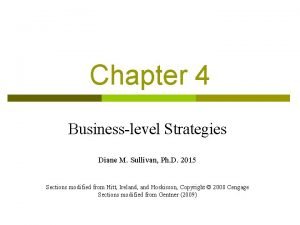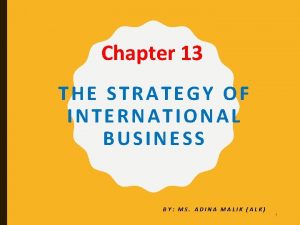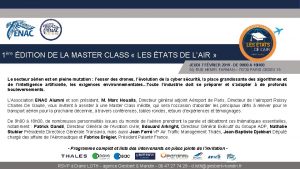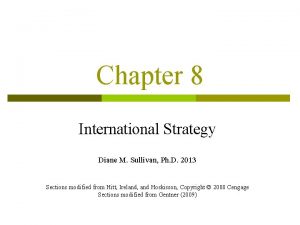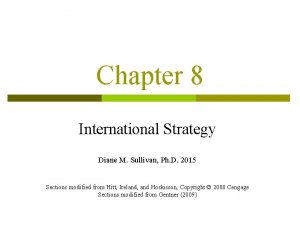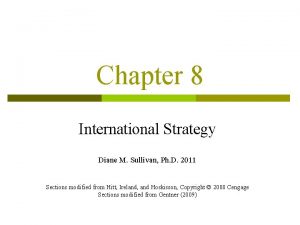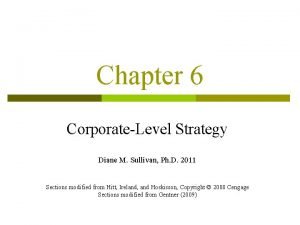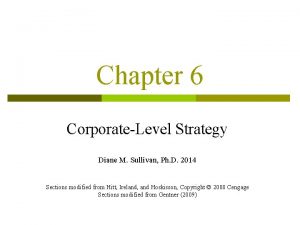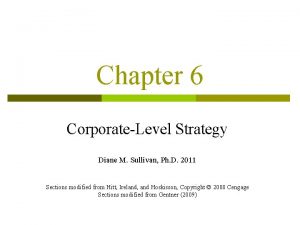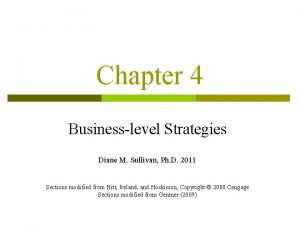Chapter 8 International Strategy Diane M Sullivan Ph
















- Slides: 16

Chapter 8 International Strategy Diane M. Sullivan, Ph. D. 2012 Sections modified from Hitt, Ireland, and Hoskisson, Copyright © 2008 Cengage Sections modified from Gentner (2009)

The Strategic Management Process p Diversification opportunities exist for firms in global markets. p When pursuing this type of diversification, they require an international strategy. p Int’l strategy can be a source of strategic competitiveness (aboveaverage returns and innovativeness) Insert figure 1. 1 graphic

International Strategy: Key Concepts p International (int’l) strategy n p A strategy through which the firm sells its goods/services outside of its domestic market. Liability of Foreignness n Difficulties firms face as they seek to manage complexities involved with international expansions/operations p Example: Disney suffered lawsuits in France because of HR policies when opened Disneyland Paris

International Strategy: Examples p Ex. 1: Shanghai Automotive Industry Corp (SAIC) n One of China’s oldest auto companies; top 3 auto firms in China p Sells autos, tractors, motorcycles, trucks, offers car leasing/financing p To grow in Chinese markets pursued joint ventures with GM & VW p Ultimate Goal: Become one of the world’s top 10 auto companies § Note: All major auto firms compete in U. S. market n n p SAIC learned from JV and licensed technology; launched own branded vehicles Now competing with GM and VW in China and wants to move in US Ex. 2: Disney n 1992, Disney moved into Europe with Euro Disney in Paris n Plagued with problems, called a “Eurodismal” n Disney suffered from liabilities of foreignness

4 Reasons Firm’s Pursue Int’l Strategies 1. 2. Increased market size n Help firms maintain growth objectives n Example: Pharmaceutical firms entering China; soft drinks Greater returns on major investments n 3. 4. Larger markets can help firms recoup investments more quickly Greater economies of scale and learning n Standardized manufacturing operations can easily capture scale economies n New learning opportunities are presented to firms A competitive advantage via location n Access to low-cost labor, energy, natural resources, supplies, customers n Example: GM’s expansion to Asia to access customers

Two Types of International Strategies 1. Business-level International Strategy n 2. Generic strategies applied to business units competing internationally Corporate-level International Strategy n n n Focuses on the scope of a firm’s operations through product and geographic diversification Required when firm operates in multiple countries or regions Required when firm operates in multiple industries and countries/regions

Business-Level International Strategy p Partially based on Porter’s “Determinants of National Advantage”

Corporate-Level International Strategy p 1. 3 International Corporate-level Strategies Global p p 2. Multidomestic p p 3. Firm offers standardized products across country markets with decision mostly dictated by the home office Example: Nike; e. Bay (initially in China and Japan) Decisions are mostly decentralized to the business unit in each country, allowing the unit to tailor products to the local market Example: Fast food; e. Bay (as a joint venture with Tom Online, Inc. ) Transnational p p p Firm seeks both global efficiency and local responsiveness Difficult to use because of conflicting goals Example: P&G uses global product business units and multidomestic market development organizations to appeal to different tastes

International Corporate-Level Strategy

5 Main Modes of Int’l Entry & Competition 1. Exporting 2. Licensing 3. Strategic Alliances 4. Acquisitions 5. New Wholly-Owned Subsidiary (“Greenfield Venture”) Easier More Difficult

Mode 1: Exporting p p Many firms begin int’l expansion via exporting goods/services to other countries Good for early-market entry and for small businesses Pros 1. Common way to enter new int’l markets 2. No need to establish operations in other countries 3. Establish distribution channels through contractual relationships with host countries Cons 1. High transportation costs 2. High import tariffs 3. Less control on marketing & distribution 4. Difficult to customize products

Mode 2: Licensing p p p Allows a foreign company to purchase the right to manufacture and sell a firm’s products within host country or set of countries Good for tactical moves and early market entry Example: Disney (US) licensed characters to LEGO (Denmark) to launch product line in US in 2010 Pros Cons 1. Firm authorizes another firm to manufacture and sell its products 1. Licensing firm loses control over product quality and distribution 2. Licensing firm is paid a royalty on each unit produced and sold 2. Relatively low profit potential 3. Licensee takes risks in manufacturing investments 3. 4. Least risky and costly way to Risk that licensor learns technology and competes when license expires

Mode 3: Strategic Alliances p p p Two or more firms develop a relationship to share their unique resources and capabilities to create an competitive advantage in an int’l location Good in uncertain situations; for tactical moves; early market entry Example: Sony (Japan) and Ericsson (Sweden) created Sony Ericsson Pros 1. 2. Firms to share risks and resources to expand into int’l ventures Most involve a foreign company with product/ technology and host company with access to distribution or knowledge of local customs, norms or politics Cons 1. Difficulties in merging disparate cultures 2. May not understand the strategic intent of partners or experience divergent goals

Mode 4: Acquisitions p p p Cross-border acquisitions Good for securing stronger presence in int’l markets Example: 1999, Wal-Mart entered the UK by acquiring ASDA Pros 1. 2. Most rapid international expansion Cons p Can be very costly p Legal and regulatory requirements may present barriers to foreign ownership p Usually require complex and costly negotiations p Potentially disparate corporate cultures Quick access to a new market

Mode 6: New Wholly Owned Subsidiary p p p Creation of a new venture, called a greenfield venture Good for securing stronger presence in int’l markets Example: 2007, Fed. Ex opened Hangzhou subsidiary in China Pros Cons 1. Achieves greatest degree of control (e. g. , full control) p Most costly and complex of entry alternatives 2. Potentially most profitable, if successful p May need expertise and knowledge that is relevant to host country 3. Maintain control over technology, marketing and distribution p May require hiring host country nationals or consultants at high cost p Must build/acquire manufacturing facilities, distribution networks, marketing strategies

Major Risks in Int’l Environments 1. 2. Political/Legal Forces n Government instability n Conflict or war n Government regulations n Conflicting and diverse legal authorities n Potential nationalization of private assets n Government corruption n Changes in government policies Economic Forces n Differences and fluctuations in currency values n Investment losses due to political risks
